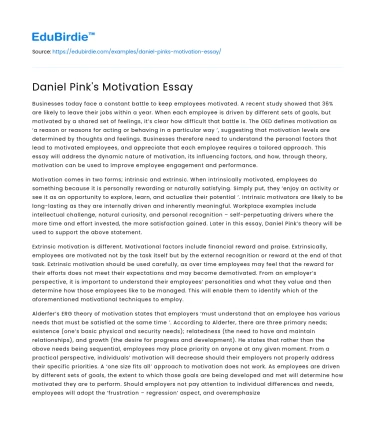Businesses today face a constant battle to keep employees motivated. A recent study showed that 36% are likely to leave their jobs within a year. When each employee is driven by different sets of goals, but motivated by a shared set of feelings, it’s clear how difficult that battle is. The OED defines motivation as ‘a reason or reasons for acting or behaving in a particular way ’, suggesting that motivation levels are determined by thoughts and feelings. Businesses therefore need to understand the personal factors that lead to motivated employees, and appreciate that each employee requires a tailored approach. This essay will address the dynamic nature of motivation, its influencing factors, and how, through theory, motivation can be used to improve employee engagement and performance.
Motivation comes in two forms; intrinsic and extrinsic. When intrinsically motivated, employees do something because it is personally rewarding or naturally satisfying. Simply put, they ‘enjoy an activity or see it as an opportunity to explore, learn, and actualize their potential ’. Intrinsic motivators are likely to be long-lasting as they are internally driven and inherently meaningful. Workplace examples include intellectual challenge, natural curiosity, and personal recognition – self-perpetuating drivers where the more time and effort invested, the more satisfaction gained. Later in this essay, Daniel Pink’s theory will be used to support the above statement.
Save your time!
We can take care of your essay
- Proper editing and formatting
- Free revision, title page, and bibliography
- Flexible prices and money-back guarantee
Extrinsic motivation is different. Motivational factors include financial reward and praise. Extrinsically, employees are motivated not by the task itself but by the external recognition or reward at the end of that task. Extrinsic motivation should be used carefully, as over time employees may feel that the reward for their efforts does not meet their expectations and may become demotivated. From an employer’s perspective, it is important to understand their employees’ personalities and what they value and then determine how those employees like to be managed. This will enable them to identify which of the aforementioned motivational techniques to employ.
Alderfer’s ERG theory of motivation states that employers ‘must understand that an employee has various needs that must be satisfied at the same time ’. According to Alderfer, there are three primary needs; existence (one’s basic physical and security needs); relatedness (the need to have and maintain relationships), and growth (the desire for progress and development). He states that rather than the above needs being sequential, employees may place priority on anyone at any given moment. From a practical perspective, individuals’ motivation will decrease should their employers not properly address their specific priorities. A ‘one size fits all’ approach to motivation does not work. As employees are driven by different sets of goals, the extent to which those goals are being developed and met will determine how motivated they are to perform. Should employers not pay attention to individual differences and needs, employees will adopt the ‘frustration – regression’ aspect, and overemphasize their other needs and become frustrated.
Low employee motivation and frustration take several different forms. These effects can stem from a single employee but soon become a firmwide issue. If employers do not take the time to understand their employees’ needs and aspirations, employees will not feel as motivated.
Absenteeism and lateness is often a sign of low motivation, as employees no longer place as much importance on their work product and presence. This in turn can lead to a negative working atmosphere, where previously motivated employees can become distracted by the lack of dedication and motivation around them. Demotivated employees then either leave (and contribute to high staff turnover) or remain within the business and further demotivate those around them. The effect of this is a drop in work quality and productivity. Unless quickly controlled, individuals, teams, and even whole organizations can suffer reputational damage as unrest quickly spreads.
The idea of control is discussed by Daniel Pink in his book ‘Drive: the surprising truth about what motivates us’. Pink argues that previous theories don’t address the needs of modern employees and fail to take account of people’s changing attitudes to work and that employees want to direct their own lives and careers. Pink suggests giving employees creative freedom to approach, manage, and execute a task, so that the focus is on getting the work done, not on how it is done. Autonomy is the first of the three elements of Pink’s motivational theory.
Mastery is the second. Pink describes employees seeing no limit to their ability, should they be given the skills, support, and time to continue to develop and ‘master’ something. He suggests setting ‘Goldilocks tasks’ that are neither too easy nor too difficult. Consequently, employees feel sufficiently stretched and pushed out of their comfort zones, but not detrimentally. Pink encourages timely and regular feedback, as ‘the only way you know you are making progress on anything is if you are getting information on how you are doing.
The final strand of Pink’s theory focuses on purpose. If people are given context on ‘the bigger picture’ (why they are doing something/how it contributes to a wider goal) Pink believes they will be more motivated to perform. Practically, employers should foster a sense of inclusion, explaining the benefits of a project not only to the business but also to the employee.
When applying Pink’s theory in the workplace, employers should divert their employees’ focus away from financial rewards and individual accolades (extrinsic) and towards personal satisfaction, development, and sense of achievement (intrinsic).
They also should promote creativity and the expression of ideas, whilst ensuring that a task’s objective has been explained and understood. By doing so, employees understand the parameters in which they are to operate but are given the freedom to do so creatively within them. Employees will feel more motivated knowing that management trusts them to ‘stretch their wings’.






 Stuck on your essay?
Stuck on your essay?

